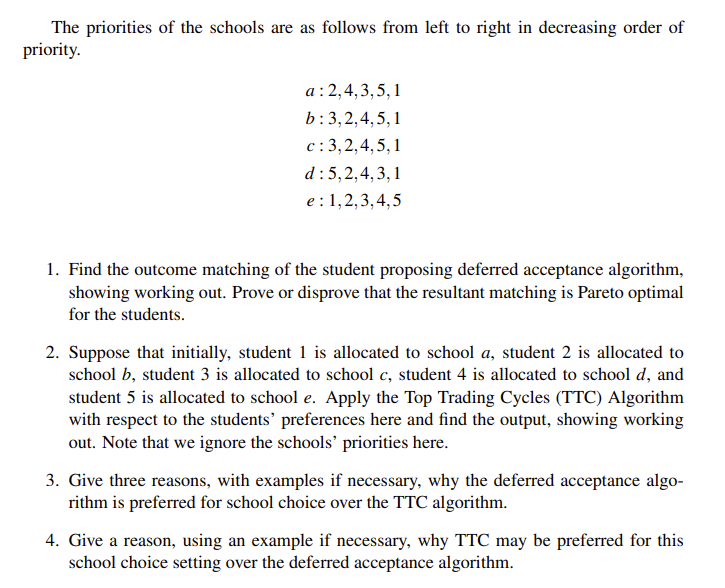Answered step by step
Verified Expert Solution
Question
1 Approved Answer
Question 3 (20 marks) Consider the following school choice problem with five students 1, 2, 3, 4, 5 and five schools a, b, c,


Question 3 (20 marks) Consider the following school choice problem with five students 1, 2, 3, 4, 5 and five schools a, b, c, d, and e with each school having exactly one seat. The preferences of the students are as follows from left to right in decreasing order of preference. 1: e,b,a,c,d 2: b,a,c,d,e 3: a,b,c,d,e 4: a,b,c,d,e 5:d,b,c,a,e The priorities of the schools are as follows from left to right in decreasing order of priority. a: 2,4,3,5,1 b: 3,2,4,5,1 c: 3,2,4,5,1 d: 5,2,4,3,1 e: 1,2,3,4,5 1. Find the outcome matching of the student proposing deferred acceptance algorithm, showing working out. Prove or disprove that the resultant matching is Pareto optimal for the students. 2. Suppose that initially, student 1 is allocated to school a, student 2 is allocated to school b, student 3 is allocated to school c, student 4 is allocated to school d, and student 5 is allocated to school e. Apply the Top Trading Cycles (TTC) Algorithm with respect to the students' preferences here and find the output, showing working out. Note that we ignore the schools' priorities here. 3. Give three reasons, with examples if necessary, why the deferred acceptance algo- rithm is preferred for school choice over the TTC algorithm. 4. Give a reason, using an example if necessary, why TTC may be preferred for this school choice setting over the deferred acceptance algorithm.
Step by Step Solution
There are 3 Steps involved in it
Step: 1

Get Instant Access to Expert-Tailored Solutions
See step-by-step solutions with expert insights and AI powered tools for academic success
Step: 2

Step: 3

Ace Your Homework with AI
Get the answers you need in no time with our AI-driven, step-by-step assistance
Get Started


